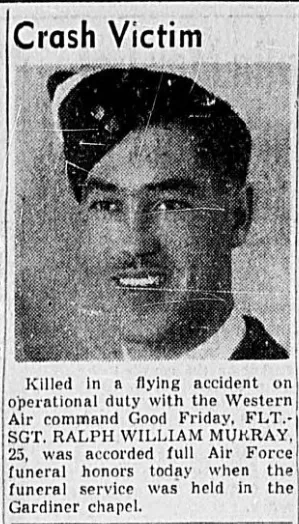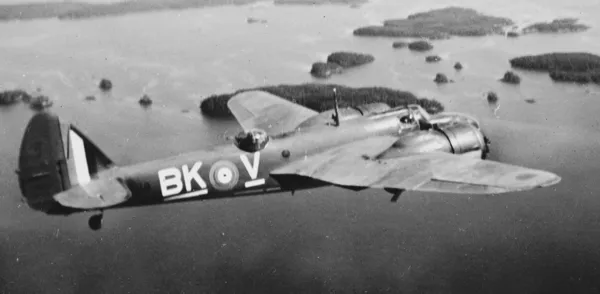Murray, Ralph William
Killed in Action 1943-04-22


Birth Date: 1918
Born:
Son of Walter T. Murray and Rebecca Murray; husband of Pauline Murray, of Winnipeg.
Home: Winnipeg, Manitoba
Enlistment:
Enlistment Date: Unknown
Service
RCAF
Unit
147 Sqn- Squadron
Base
Rank
Flight Sergeant
Position
Flight Sergeant
Service Numbers
R/90833
Home
 Winnipeg, Manitoba
Winnipeg, Manitoba
First Burial
 Brookside Cemetery At Winnipeg, Manitoba
Brookside Cemetery At Winnipeg, Manitoba
This incident involved multiple aircraft:
- Bolingbroke Mk. IV Serial: 9038
All the above aircraft in the above list are referenced in this report.
Bristol Bolingbroke

Fairchild Bolingbroke Mk. IV, RCAF (Serial No. 9118), coded BK-V, No. 115 (Bomber Reconnaissance) Squadron, Patricia Bay, British Columbia, 1942.
The Bristol Fairchild Bolingbroke was a maritime patrol aircraft and trainer used by the Royal Canadian Air Force during the Second World War. Built by Fairchild-Canada, it was a license-built version of the Bristol Blenheim Mk IV bomber.
In 1935, the British Air Ministry issued Specification G.24/35 to procure a coastal reconnaissance/light bomber to replace the Avro Anson. Bristol proposed the Type 149, based on its Blenheim Mk I, with Bristol Aquila engines to give greater range. While the Air Ministry rejected this proposal, a Blenheim Mk I, retaining its Mercury VIII engines, was converted as a Type 149 (Blenheim Mk III) for the general reconnaissance role.The nose was lengthened to provide more room for the bombardier, with the upper left surface of the nose being scooped out to maintain pilot visibility during takeoff and landing.
The longer range also fulfilled a Canadian requirement for a maritime patrol aircraft. Consequently, Fairchild Aircraft Ltd. (Canada) of Quebec started production of the Blenheim Mk IV as the Bolingbroke (the originally intended name for the Blenheim IV). This type was nicknamed the "Bolly". After a small run of aircraft constructed to British specifications, as the Bolingbroke Mk I, Fairchild switched production to the Bolingbroke Mk IV with Canadian and American instruments and equipment. These versions also included anti-icing boots and a dinghy. One of the early Mk IV variants was the Bolingbroke Mk IVW which was powered by two 825 hp (615 kW) Pratt & Whitney SB4G Twin Wasp Junior engines. Incapable of maintaining altitude on one engine, the normal bomb load was reduced to 500 pounds on these aircraft to compensate for the low engine power. The most-produced variant was the Bolingbroke Mk IVT trainer, of which 457 were completed. A total of 626 Bolingbrokes were produced.Wikipedia
Bolingbroke 9038
Bolingbroke Mk. IV 9038
First used by No. 8 (BR) Squadron at RCAF Station Sydney, NS. Category B crash at Sydney aerodrome at 17:50 on 1 November 1941. To No. 4 Repair Depot at Dartmouth on 3 November 1941. To Western Air Command on 20 August 1942. Probably used by No. 147 (BR) Squadron at RCAF Station Tofino, BC. Crashed and burned at Tofino on 22 Apr 1943 after control was lost during night take-off with Gyros (AH and DI) left caged; Flying Officer W. Hanchet, Pilot Officer V. Martin, and Flight Sergeant R. Murray were all seriously injured, Flight Sergeant Murray later died of his injuries. Written off at 147 Squadron.{{link,canadaprimary,https://heritage.canadiana.ca/view/oocihm.lac_reel_c5933/1274,RCAF - Accident Investigation File}}
{{link,canadaprimary,https://heritage.canadiana.ca/view/oocihm.lac_reel_c5933/1302,RCAF - Accident Investigation File - Second File}}
1941-09-18 Taken on Strength Eastern Air Command 2019-08-20
1941-November-01 Accident: 8 Squadron Loc: Aerodrome Names: Casey | MacDonald | Mcmurray | Robb
1943-April-22 Accident: 147 Squadron Loc: Aerodrome Names: Hanchet | Martin | Murray
1943-05-27 Struck off Strength Struck off, reduced to spares and produce 2019-08-20
 Canadian Virtual War Memorial
Canadian Virtual War Memorial Commonwealth War Graves Commission
Commonwealth War Graves Commission www.findagrave.com
www.findagrave.com Wikipedia Bolingbroke Bomber
Wikipedia Bolingbroke Bomber Harold A Skaarup Web Page
Harold A Skaarup Web Page Bolingbroke Bomber WWII
Bolingbroke Bomber WWII Bolingbroke - Kestrel Publications
Bolingbroke - Kestrel Publications